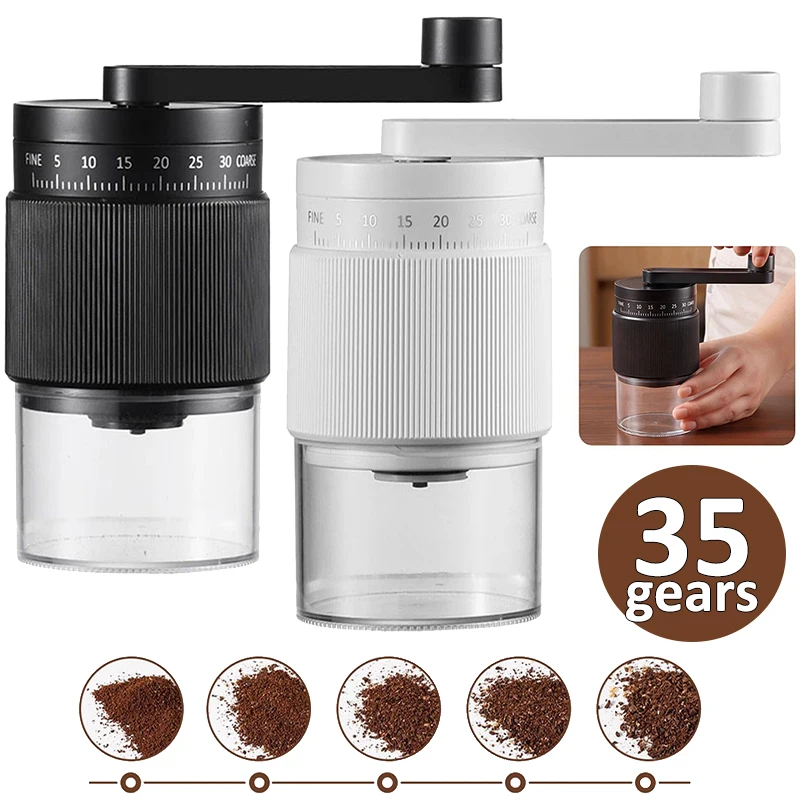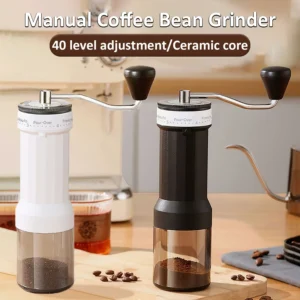Why Coffee Grinder Burrs Are Critical to Your Brewing Experience
When it comes to brewing exceptional coffee at home, the grinder you use makes a profound difference in your cup quality. At the heart of every quality grinder lie the burrs – the grinding mechanism that transforms your whole beans into perfectly sized particles for extraction. These humble components are perhaps the single most important factor determining your coffee’s flavor potential.
The debate between ceramic and steel burrs has long divided coffee enthusiasts. This distinction isn’t merely academic – your choice directly impacts grind consistency, heat generation, durability, and ultimately, the flavors in your cup. Understanding the fundamental differences between ceramic vs steel burr coffee grinders helps you make more informed decisions about which grinder might best serve your brewing needs.
Burr material affects everything from how evenly your coffee extracts to how often you’ll need to replace parts. As we explore the longevity and performance aspects of these materials, we’ll examine the critical factors that should guide your selection process – from initial sharpness to heat generation, maintenance requirements, and long-term value.
Understanding Burr Longevity Measurements
Before diving into specific materials, it’s important to understand how we measure burr longevity. Unlike many kitchen tools that wear out based on time alone, coffee grinder burrs degrade primarily based on the amount of coffee processed through them. This is typically measured in pounds or kilograms of coffee ground.
For the average coffee drinker preparing about one pound (453g) of coffee weekly, this translates to roughly 52 pounds (23.6kg) per year. However, true longevity isn’t just about physical durability – it’s about maintaining consistent grind quality throughout the burr’s lifetime.
Several universal factors affect all burr types regardless of material:
- Usage frequency: Daily grinding accelerates wear compared to occasional use
- Bean hardness: Lighter roasts are denser and harder, causing more burr wear
- Grind settings: Finer settings create more friction and accelerate wear
- Foreign objects: Stones or debris can cause immediate damage to any burr type
- Cleaning habits: Regular maintenance significantly extends burr life
Understanding these factors provides context for the ceramic vs steel grinder burrs comparison and helps explain why performance can vary significantly between seemingly similar grinders. Now let’s examine each material in detail.
Ceramic Burrs: Material Properties and Composition
Ceramic burrs are typically manufactured from zirconium oxide (zirconia), an incredibly hard material that ranks around 9 on the Mohs hardness scale (diamond is 10). In Rockwell hardness terms, this translates to approximately 75-80 HRC – significantly harder than most metals.
This exceptional hardness comes from zirconia’s crystalline structure, which creates micro-edges that maintain sharpness over extended use. The material’s molecular composition gives it remarkable resistance to wear even when repeatedly grinding hard coffee beans.
Beyond hardness, ceramic offers two other significant material advantages. First, it conducts heat poorly, meaning it doesn’t absorb or transfer much heat during grinding. Second, as a non-metallic material, it’s completely immune to rust and corrosion, which can be significant factors in humid environments.
The manufacturing process for ceramic burrs involves pressing zirconia powder into shape and then firing it at extremely high temperatures to create the final hardened product. This results in burrs that hold their edge exceptionally well but can be more brittle than their metal counterparts.
Our ceramic burr coffee grinder collection showcases how manufacturers leverage these material properties to create durable grinding solutions.
Ceramic Burr Performance Profile
When it comes to longevity, ceramic burrs excel. Most quality ceramic burrs can process between 1000-1500 pounds (450-680 kg) of coffee before significant performance degradation occurs. For the average home user grinding a pound of coffee weekly, that translates to approximately 19-29 years of service from a single set of ceramic burrs!
The grinding consistency characteristics of ceramic burrs remain remarkably stable over their lifetime. Unlike steel, which may produce increasingly inconsistent particle sizes as edges dull, ceramic tends to maintain its grinding profile much longer. This consistency is particularly valuable for brewing methods that demand precise particle size distribution, such as espresso.
The thermal properties during grinding represent another significant advantage. Ceramic’s poor heat retention between steel vs ceramic means less heat transfers to your coffee grounds during the grinding process. This thermal stability helps preserve volatile aromatic compounds in your coffee beans that might otherwise be prematurely released by excess heat.
Ceramic burrs also tend to operate more quietly than steel alternatives, producing a less metallic, more muted grinding sound. For grind settings, ceramic burrs typically perform best at fine to medium settings, making them particularly well-suited for espresso preparation.
Advantages and Limitations of Ceramic Burrs
Understanding the strengths and weaknesses of ceramic burrs helps determine if they match your coffee brewing needs.
Advantages:
* Superior edge retention for consistent grinding over many years
* Minimal heat transfer protects delicate coffee flavors
* Complete immunity to rust and corrosion
* Exceptional consistency for espresso and fine-to-medium grinds
* Quieter operation compared to steel alternatives
Limitations:
* More brittle nature creates risk of chipping if foreign objects enter
* Higher upfront cost than standard steel burrs
* Difficult or impossible to resharpen once worn
* May struggle with coarse grinding uniformity
* Can crack if dropped or subjected to impact
The influence of burr material on coffee flavor is significant. The coffee flavor from ceramic steel burrs differs primarily because ceramic’s thermal properties help preserve more volatile compounds during grinding, potentially yielding brighter, more nuanced flavor profiles.
Steel Burrs: Material Properties and Types
Steel burrs represent the traditional and most common burr material, available in several variations with distinct properties.
Standard stainless steel burrs typically measure between 50-58 HRC on the Rockwell hardness scale – significantly softer than ceramic but offering excellent toughness and resistance to breaking. High-carbon steel burrs range from 58-62 HRC, while premium tool steel burrs can reach 62-65 HRC, approaching ceramic’s hardness while maintaining steel’s inherent strength.
The manufacturing process for steel burrs involves precision cutting or machining hardened steel followed by surface treatments to enhance durability. This creates burrs with extremely sharp initial edges, though these edges typically dull faster than ceramic.
Unlike ceramic’s brittleness, steel’s primary advantage is its toughness – the ability to withstand impacts without cracking or breaking. This makes steel burrs nearly impervious to the occasional rogue stone or foreign object that might damage ceramic burrs.
The metallurgical composition varies significantly between manufacturers, with premium models using higher carbon content, additional alloying elements, or specialized heat treatments to enhance performance characteristics.
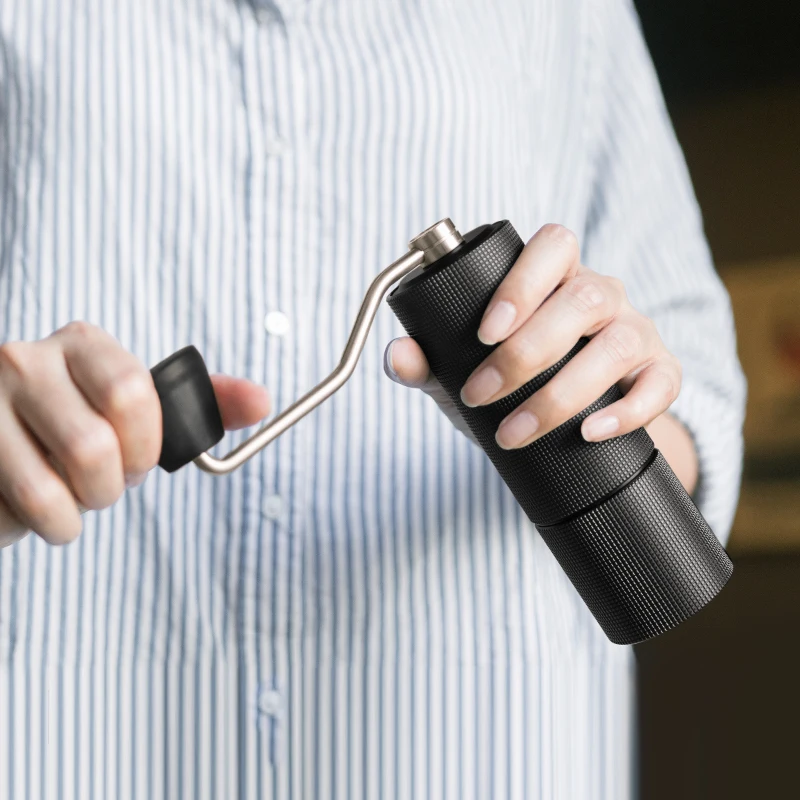
Our selection of stainless steel manual coffee grinders showcases the durability and precision these burrs offer across various price points.
Standard Steel Burr Performance Profile
Standard steel burrs typically process between 500-1000 pounds (225-450 kg) of coffee before requiring replacement – roughly half the lifespan of ceramic alternatives. For the average home user, this translates to approximately 10-19 years of service, still impressive longevity.
Steel burrs begin with exceptional sharpness, often providing superior initial grind consistency compared to ceramic. However, this advantage gradually diminishes as the cutting edges dull with use. The grind consistency typically remains excellent for the first 300-500 pounds of coffee, then gradually becomes less uniform.
Thermal characteristics represent a key difference between materials. Steel conducts heat much more efficiently than ceramic, which means it can absorb and transfer more heat to your coffee grounds during grinding. This metal ceramic burrs heat comparison shows how extended grinding sessions can potentially impact flavor by slightly warming the grounds.
Steel burrs generally excel at producing consistent coarse grinds, making them particularly well-suited for brewing methods like French press, pour-over, and drip coffee. They tend to perform less optimally at extremely fine settings as they wear.
Corrosion resistance varies significantly between steel types. Basic stainless steel offers good protection in normal conditions, while higher-quality stainless alloys provide superior resistance even in humid environments.
Advantages and Limitations of Standard Steel Burrs
Understanding steel burrs’ strengths and weaknesses helps determine if they align with your brewing preferences and maintenance habits.
Advantages:
* Superior impact resistance and toughness
* More affordable initial cost than ceramic
* Exceptional initial sharpness for clean cutting
* Better consistency for coarse grinding applications
* Can potentially be resharpened by professionals
Limitations:
* Faster dulling compared to ceramic burrs
* Greater heat generation during extended grinding
* Potential rust issues with some steel types
* Requires more frequent cleaning and maintenance
* May not maintain fine grind consistency as long as ceramic
For coffee enthusiasts exploring their options, our collection of manual coffee burr grinders includes both steel and ceramic varieties to match different brewing preferences and budgets.
Advanced Burr Coatings: The Game-Changer for Steel
Recent innovations in burr technology have introduced specialized coatings that dramatically enhance steel burr performance, effectively addressing many traditional limitations.
These coatings were developed specifically to improve hardness, reduce friction, and extend longevity without sacrificing steel’s inherent toughness. The most common advanced coatings include:
| Coating Type | Hardness Increase | Lifespan Extension | Key Benefits |
|---|---|---|---|
| Titanium Nitride (TiN) | +20-25% | 3-5x | Gold color, improved wear resistance |
| Diamond-Like Carbon (DLC) | +30-40% | 5-10x | Ultra-low friction, excellent heat reduction |
| Titanium Aluminum Nitride (AlTiN) | +25-30% | 4-6x | Superior hardness at high temperatures |
| Red Speed | +35-45% | 6-10x | Extremely low friction, premium coating |
These coatings create a surface layer significantly harder than the base steel, with some approaching or even exceeding ceramic’s hardness while maintaining steel’s structural toughness. The result is dramatically improved performance:
- Longevity improvements that match or exceed ceramic burrs
- Reduced heat generation due to lower friction coefficients
- Extended maintenance of grinding consistency over time
- Improved corrosion resistance
While coated burrs come with a premium price tag, their cost-benefit analysis often favors them for serious coffee enthusiasts. The best materials for burrs often incorporate these advanced coatings, especially for users who grind daily or demand maximum consistency.
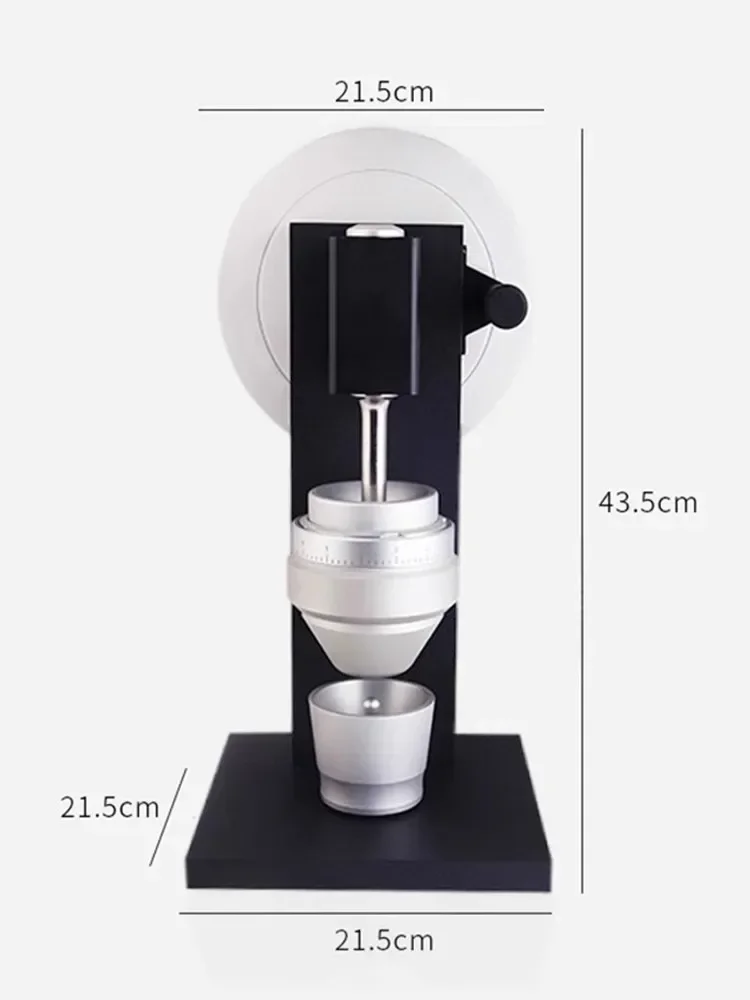
Side-by-Side Comparison: Ceramic vs. Steel vs. Coated Steel
This comprehensive comparison helps visualize the key differences between burr types:
| Factor | Ceramic Burrs | Standard Steel Burrs | Coated Steel Burrs |
|---|---|---|---|
| Longevity (lbs of coffee) | 1000-1500 lbs | 500-1000 lbs | 1500-3000+ lbs |
| Years for avg. home user | 19-29 years | 10-19 years | 29-58+ years |
| Material Hardness | Very high (75-80 HRC) | Moderate (58-65 HRC) | High to very high (70-85 HRC) |
| Breakage Resistance | Low (brittle) | High (tough) | High (tough) |
| Heat Generation | Minimal | Moderate to high | Low to moderate |
| Initial Grind Quality | Very good | Excellent | Excellent |
| Long-term Consistency | Excellent | Good | Excellent |
| Maintenance Needs | Low | Moderate | Low |
| Relative Price | High | Moderate | Very high |
| Best Use Case | Espresso, fine grinds | Coarse to medium grinds | All-purpose, heavy use |
This ceramic vs steel burr comparison demonstrates how each material offers distinct advantages depending on your brewing preferences, budget constraints, and usage patterns.
Identifying Worn Burrs: Key Signs and Indicators
Recognizing when your burrs are wearing out helps maintain coffee quality and prevents unnecessary replacements. Watch for these telltale signs:
- Inconsistent grind size: Noticeably more fines and boulders in your ground coffee
- Extended grinding times: The same amount of beans takes significantly longer to grind
- Motor strain: Electric grinders may sound labored or struggle to maintain speed
- Declining flavor clarity: Coffee tastes flat, muddy, or lacks the brightness it once had
- Unusual sounds: New clicking, scraping, or grinding noises during operation
- Visual changes: Visible flattening of cutting edges or surfaces
Ceramic and steel burrs show different wear patterns. Ceramic burrs typically maintain their general shape but develop microscopic wear on cutting edges. Steel burrs show more visible flattening of the cutting surfaces and may develop rounded edges where they were once sharp.
Our manual burr mill collection features replaceable burrs, making maintenance simpler when wear eventually occurs.
Maximizing Burr Longevity: Essential Maintenance Practices
Proper maintenance dramatically extends burr life regardless of material type. These simple practices make a significant difference:
- Regular cleaning: Remove coffee oils and particles every 1-2 weeks for daily users
- Proper technique: Always clean with brushes, compressed air, or specialized grinder cleaning products
- Bean inspection: Check beans for foreign objects before grinding
- Appropriate settings: Avoid adjusting grind size while the burrs are empty
- Gentle usage: Don’t overfill the hopper or force beans into the grinding chamber
Damaging practices to avoid include:
* Grinding non-coffee items (spices, etc.)
* Using water to clean burr mechanisms
* Forcing burrs to grind finer than designed
* Dropping or impacting the grinder
* Adjusting settings while the grinder is running
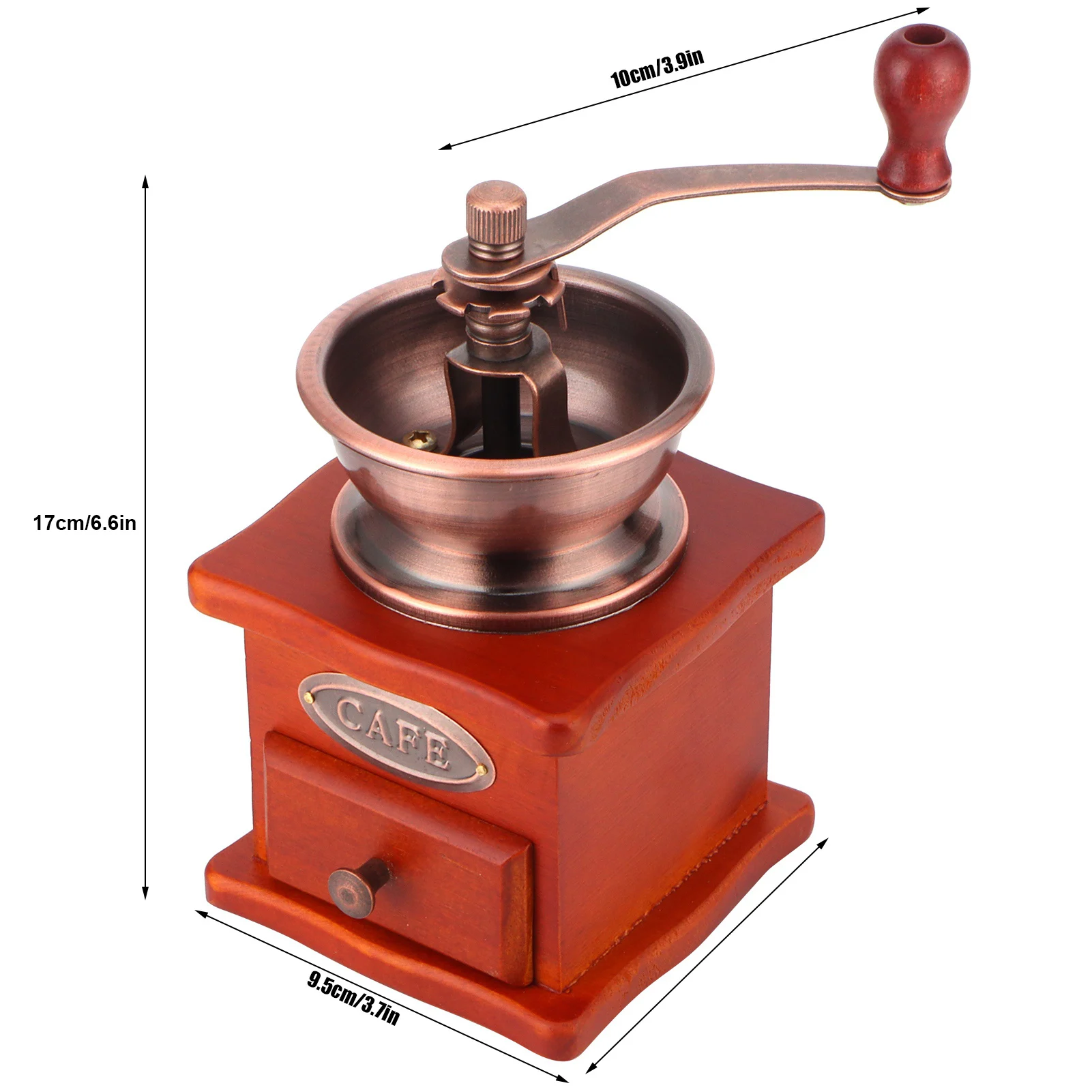
For detailed guidance on proper maintenance techniques, our guide on manual burr coffee grinder cleaning provides step-by-step instructions to ensure your grinder performs optimally for years.
Making Your Choice: Matching Burr Type to User Needs
Selecting the ideal burr material depends largely on your specific brewing preferences and habits:
For espresso enthusiasts:
Ceramic burrs often excel for dedicated espresso preparation due to their exceptional consistency at fine settings and minimal heat transfer. Their stable performance over time helps maintain the precise grind needed for consistent shots.
For filter coffee lovers:
Standard steel burrs typically provide excellent performance for medium to coarse grinds used in pour-over, French press, and drip brewing. Their sharp cutting action produces clean particle distribution ideal for these methods.
For multi-method brewers:
Coated steel burrs offer the best all-around performance for those who regularly switch between brewing methods. Their durability and consistency across grind settings make them versatile enough to handle everything from espresso to cold brew.
Hand Burr Grinder, Hand Crank Coffee Grinder, Manual Espresso Grinder, Portable Coffee Grinder
Price range: $262.72 through $300.22 Select options This product has multiple variants. The options may be chosen on the product pageManual Burr Mill, Manual Coffee Grinder Stainless Steel, Manual Coffee Mill Grinder, Mechanical Coffee Grinder
Price range: $127.26 through $130.32 Select options This product has multiple variants. The options may be chosen on the product pageHand Burr Grinder, Manual Coffee Grinder Stainless Steel, Precision Manual Grinder
Price range: $183.64 through $187.52 Select options This product has multiple variants. The options may be chosen on the product pageCeramic Burr Coffee Grinder, Hand Burr Grinder, Hand Crank Coffee Grinder, Manual Coffee Bean Grinder
Price range: $59.17 through $59.96 Select options This product has multiple variants. The options may be chosen on the product page
Budget considerations also play an important role in burr selection. While ceramic and coated steel burrs cost more initially, their extended lifespan often provides better long-term value for dedicated daily users. Standard steel offers an excellent entry point for occasional users or those exploring specialty coffee.
The ultimate guide to burr materials for espresso provides deeper insights for those specifically focused on preparing exceptional espresso.
Frequently Asked Questions About Burr Longevity
How long will burrs last for an average home user?
For someone grinding 1-2 pounds of coffee monthly, ceramic burrs typically last 15+ years, standard steel 8-12 years, and coated steel potentially 20+ years with proper maintenance.
Should I replace my burrs or buy a new grinder when performance declines?
If your grinder is high-quality with replaceable burrs, replacing just the burrs is usually more economical. For entry-level grinders, the cost of replacement burrs sometimes approaches that of a new grinder.
Can worn burrs be resharpened?
Steel burrs can sometimes be professionally resharpened, though results vary. Ceramic burrs generally cannot be resharpened and must be replaced when worn.
Are expensive burrs worth the investment?
For daily coffee drinkers who can detect subtle flavor differences, premium burrs offer noticeably better grind consistency and flavor clarity. Occasional users may not justify the additional cost.
Do different burr materials actually affect coffee flavor?
Yes. Steel burrs can impart slightly more heat during grinding, potentially affecting delicate aromatics, while ceramic’s cooler operation preserves more volatile compounds. The difference is subtle but detectable to experienced tasters.
For those seeking portable grinding solutions, our hand burr grinder collection offers excellent options with both ceramic and steel burrs.
Conclusion: Investing in Quality for Better Coffee
The choice between ceramic and steel burrs represents a meaningful decision for any coffee enthusiast. Ceramic burrs offer exceptional longevity and thermal stability, making them ideal for espresso preparation and those seeking minimal maintenance. Standard steel burrs provide superior toughness and initial sharpness at a more accessible price point, while coated steel burrs combine the best aspects of both materials for premium performance.
Rather than declaring a single “best” option, the ideal burr material depends on your brewing methods, maintenance habits, and budget. By understanding the unique properties of each material, you can select a grinder that delivers consistent, flavorful results for years to come.
Regardless of which material you choose, quality burrs represent one of the most impactful investments you can make in your coffee journey. The precision and consistency they provide transform your daily brewing routine, revealing flavors and aromas that pre-ground coffee simply cannot preserve.

